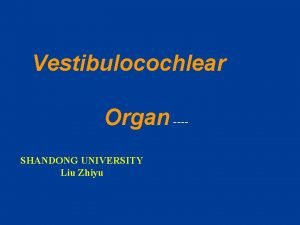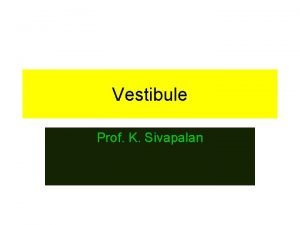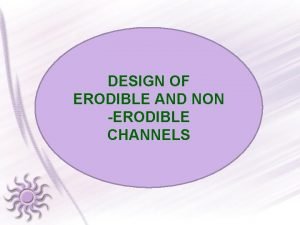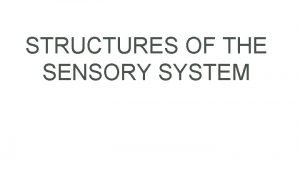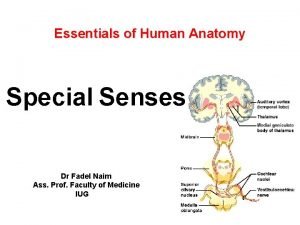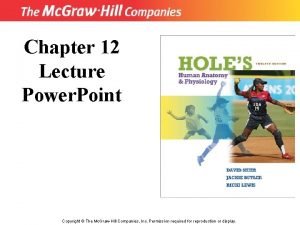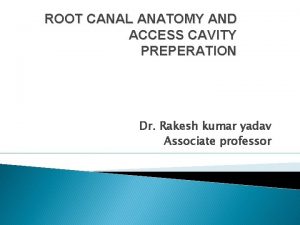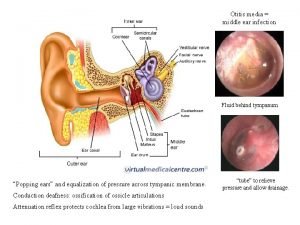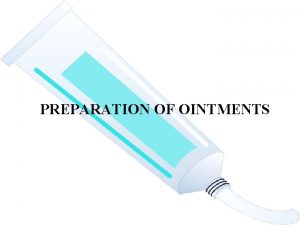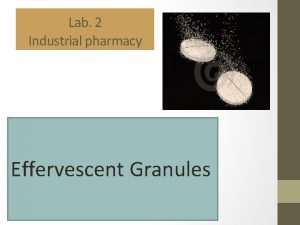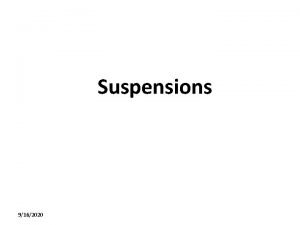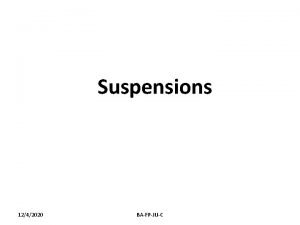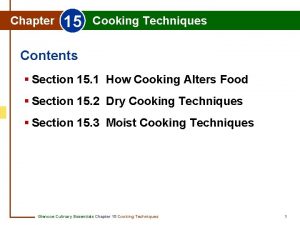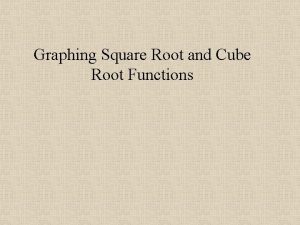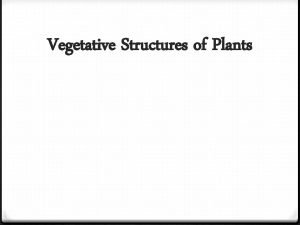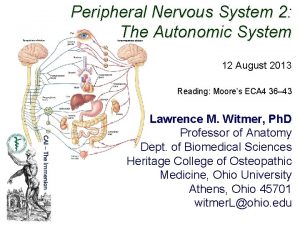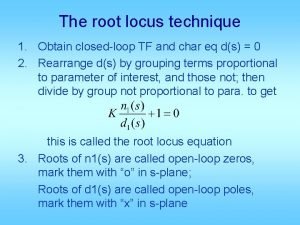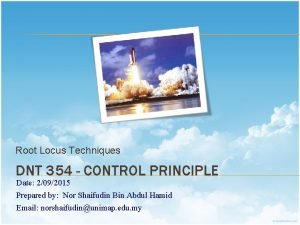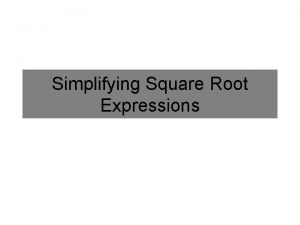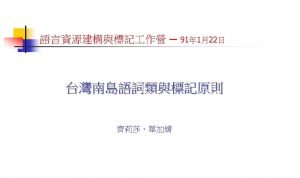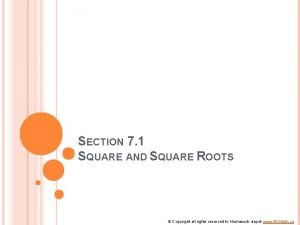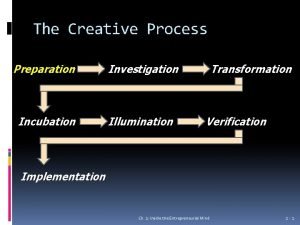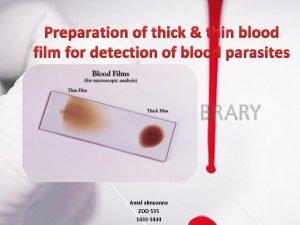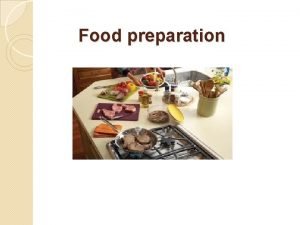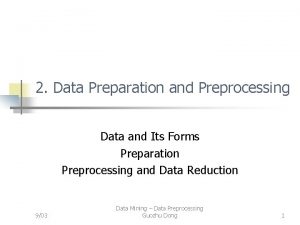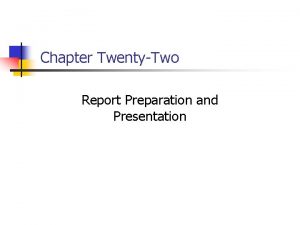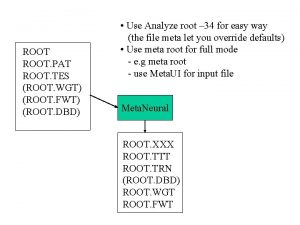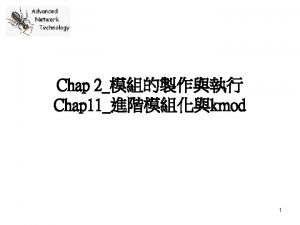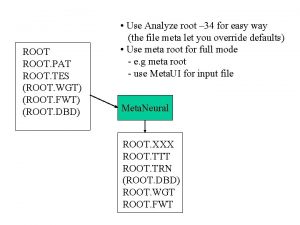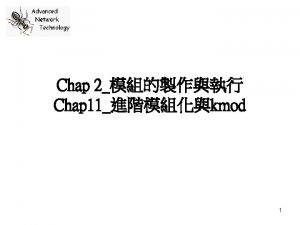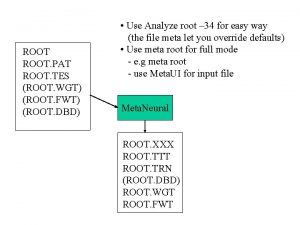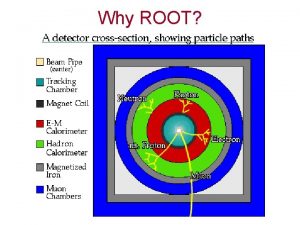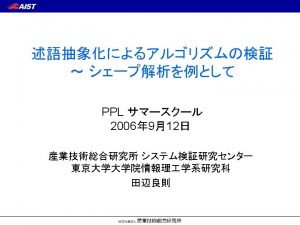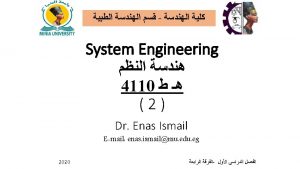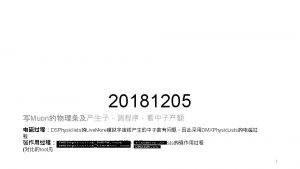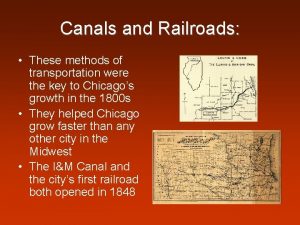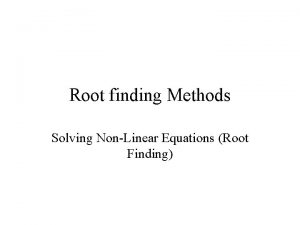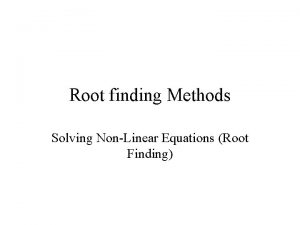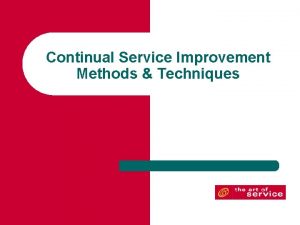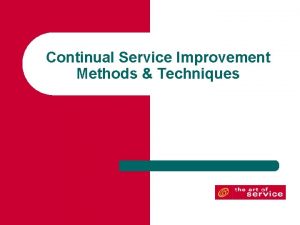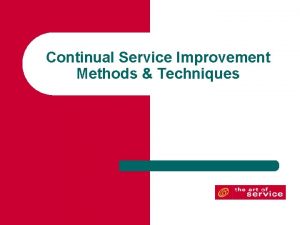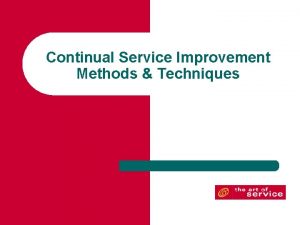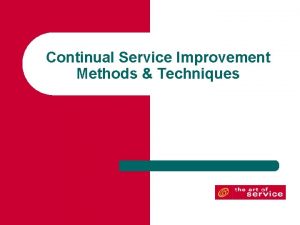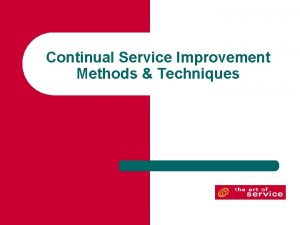TECHNIQUES AND METHODS OF PREPARATION OF ROOT CANALS


















































- Slides: 50

TECHNIQUES AND METHODS OF PREPARATION OF ROOT CANALS MDDr. Radovan Žižka

AIM OF SEMINARY � Aim of endodontic treatment � Shaping and cleaning �Schilder (1974) �Contemporary aproach � Concepts which are used during root canal preparation � Techniques and methods of preparation of root canals

AIM OF ENDODONTIC TREATMENT � Aim of endodontic treatment is desinfiction of root canal, which is followed by hermetic obturation

SHAPING AND CLEANING � Shaping –the purpose is to prepare a shape of root canal which respects original anatomy and makes possible thorought cleaning and hermetic obturation � Cleaning – the purpose is to remove all the material in root canal (pulp, preparation debris, microorganisms)

SHAPING AND CLEANING (Schilder, 1974) � Shaping � Mechanical aims � Biological aims � Cleaning � Exstirpation � Dissolving material of biological origin � Removing preparation debris

SHAPING AND CLEANING (contemporary aproach) � Kompletní přístup � Direct view on the whole pulp chamber floor and its morphology (root canal orifices) � Straight line access � Continuously narrowing preparation � Allows irrigation and removing of debris � Allows hermetic obturation

SHAPING AND CLEANING (contemporary aproach) � Respecting original anatomy � Shape of root canal preparation respects and follow original anatomy � Protecting healthy teeth structures � Increase resistance against fracture � Decrease probability of perforation � Apical preparation should be as small as it is possible to procede adequate cleaning

CONCEPTS USED DURING PREPARATION � Straight line access (SLA) � Coronal flaring � Working lenght (WL) � Apical width (AW) � Patency � Recapitulation � Glidepath

STRAIGHT LINE ACCESS � Ideally should working instrument reach foramen fysiologicum (or first curvature) without bending. � Influenced by: � Shape of access cavity � Coronal flaring

CORONAL FLARING � Before we reach working lenght with ours instrument we should procede coronal flaring � Remove the most infected tissue in root canal � Create reservoir for irigation sollution � Allows straight line access

CORONAL FLARING � Gates-Glidden � Rotatory endodontic files � Pro. Taper SX � Pro. File orifice shapers Zdroje: http: //www. dentalcapitalbh. com. br/media/endodontia-maillefer/PROFILE-ORIFICE-SHAPER. jpg http: //t 2. gstatic. com/images? q=tbn: ANd 9 Gc. RFzd 64 ff. Fl. SVl. Bgq. Le. Rkas-DSIzpjv. Io. BZFr. X 5 AWN 41 mk 1 Wcew. Zw http: //t 2. gstatic. com/images? q=tbn: ANd 9 Gc. Q 1 pep 7_Ao. QOTj-39 l 2 cm. Mbq. Ltdv-GFWtw. Tb 8 lpg. Ig. Pj. W 0 Yn. YD 4

WORKING LENGHT � Lenght of working instrument from reference point to foramen fysiologicum (boundary between cement and dentin) Dentin Cement Pulp tissue Foramen fysiologicum

WORKING LENGHT � We can find it out � Average values – very unprecise. Can be used only as safe lenght � Radiologically – unprecise. Fysiological foramen is usually about 1 -1, 5 mm from anatomical apex � Electronically– electronic apex locator (EAL) are based on pricipal that resistance between oral mucosa and periodontal ligaments is constant

APICAL WIDTH � Depends on original diameter and shape of root canal, used taper of instrume and diagnosis • High taper • Less infected root canals • Small diameter(incisors, calcification) • Unpleasant root canal anatomy • Low taper • Badly infected root canal • Root canal retreatment • Bigger diameter(young patiens, palatal root of M 1)

PATENCY Keeping apical foramen free of debris by using patency file (usually Kfile size #10 or #15) that is passively extended just through apical foramen � Helps to maintain working lenght � Helps to removing preparation debris Foramen fysiologicum � Foramen apicale Patency file

RECAPITULATION Checking the working lenght with the working instruments with a 1 ISO smaller diameter than working instrument we have used before � Helps to maintain working lenght � Helps to remove preparation debris �

GLIDEPATH � Using of (usually) stainless steel files before Ni-Ti rotarory files � Producing smooth reproducible glide path for rotatory instruments � Preparation at least to ISO 15(allows removing preparation debris) � Checking straight line access � Valuable information abou root canal anatomy

TECHNIQUES AND METHODS OF ROOT CANAL PREPARATION � Technique file – instrumentation with one � Method – instrumentation sequence (can obtain more techniques) � We divide to hand, rotatory, hybrid (following are hand ones)

TECHNIQUES OF ROOT CANAL PREPARATION � Standarized (watch-winding) � Reaming � Filing � Balanced force

STANDARDIZED TECHNIQUE � Indication � Initial probing of root canal � Recapitulation � Retreatment � Complication � Extrusion of preparation debris beyond apex � Ledge � Instruments � K-reamer, K-file

STANDARDIZED TECHNIQUE Instrument is pushing apically during rotating in clock-wise and anti clock-wise direction (about 45°) 15

REAMING TECHNIQUE � Indication � Straight root canals of circular diameter � Complication � Straightening of root canals � Zip-elbow � Instruments � K-reamer � K-file (rotation 45°) (rotation less than 45°)

REAMING TECHNIQUE We pass instrument passivelly to root canal and then we rotate it around 45° with small presure. Then we take the instrument out. 15

FILING TECHNIQUE � Indication � Oval shape root canals � Retreatment � Smoothing the preparation � Complication � Extruding debris through apex � Instrument � H-file

FILING TECHNQUE We insert instrument passivelly and then pull it up 2 -3 mm agains root canal wall. It´s neccesary to irigate very often and equal preparation of walls. 15

BALANCED FORCE TECHNIQUE � Indication � Complicated root canal anatomy � The most universal technique for glidepath � Complication � Straightening of root canal � Instrument � K-flexofile (Flex-R file) � K-file

BALANCED FORCE TECHNIQUE STEP 1 Insert instrument passively which has 1 ISO diameter larger than current master apical file. 15

BALANCED FORCE TECHNIQUE STEP 2 With small pressure we rotate instrument around 90° in the clock-wise direction. Instrument will engage dentin of the root canal wall. 15

BALANCED FORCE TECHNIQUE STEP 3 With minimal pressure we rotate instrument around 180 -270° counter clockwise direction. Pressure should maintain instrument at or near the clockwise insertion depth. It will break loose the engaged dentin chips from root canal wall. 15

BALANCED FORCE TECHNIQUE STEP 4 The file si then removed from root canal by a slow clockwise rotation around 360° that loads debris into the flutes and elevates is away. 15

BALANCED FORCE TECHNIQUE STEP 4 Because we don´t use prebend files the straightening of root canal can occur. If root canal is complicated we suggest instead of step 4 go on with step 1 until the working lenght is reached. (ledge and breakage are more probable)

METHODS OF ROOT CANAL PREPARATION � Apicocoronal – we prepara from begging with complete working lenght or we shorten it. � Combined (reaming-filing) � Step-back � Coronoapical – we prepare with shortened working lenght which is further prolonged. � Step-down � Double flared � Crowndown presureless

COMBINED METHOD � Indication � Straight canals (oval) � Recreation of apical stop after overinstrumentation of apex � Complication � Zip-elbow, perforation (in case of curvature in apical part of root canal) � Instruments � Changing of K-file and H-file

COMBINED METHOD By K-file we prepare with balanced force technique up to working lenght Then passively insert H -file and with filing technique we prepare root canal We repeat whole procedure with files 1 ISO larger. 15 20

STEP-BACK METHOD � Indication � Mediate to severe curved canals � Complication � Reduction of their occurence � Time demanding � Instruments � In the past prebend H-file, these days are prefered K-files

STEP-BACK METHOD � Main idea is continuous shortening the working lenght of instruments with larger diameter � It consists of two steps � Preparation of apical stop � Preparation of continuously widening taper

STEP-BACK METHOD � Preparation of the apical stop which has adequate diameter at the correct working lenght ( for example ISO 35) � Next instrument is insterted to shortened working lenght (original working lenght – 0, 5 mm) and preparation is repeated � In the end we prepare with master apical file to make root canal walls smooth 60 55 50 45 40 35

STEP-DOWN METHOD � Indication � Formerly invented for molards � Mildly curved, rather oval root canals � Complication � Reduction of occurence � Time demanding � Instruments � Combination of K-file, H-file, Gates-Glidden

STEP-DOWN METHOD � Contains � Aim 3 steps is to: � Determine working lenght which is constant � Minimalize the possiblity of extrusion the debris throught apex � Precise recognition of apical width

STEP-DOWN METHOD 1. Step Preparation of coronal 2/3 of root canal with filing technique (H-files ISO 15, 20, 25), working lenght can be determined with ISO 8 instrument. 2/3 25 15 20

STEP-DOWN METHOD 2. Step Coronal flaring with Gates-Glidden (1 -4), or Pro. Taper/Pro. File 2/3

STEP-DOWN METHOD 3. Step Preparation to working lenght (min. ISO 35) with balanced force technique and followed by step-back technique

DOUBLE FLARED METHOD � Indication � Almost no restriction � Complication � Reduction of occurence � Instruments � K-file, Gates-Glidden

DOUBLE FLARED METHOD In fact it´s step-down method where the first step is missing. Thorought coronal flaring brings same advantages as with step-down method. In the same time is reduced possibility of extruding infection apically Koronal flaring + step-back

DOUBLE FLARED METHOD 1. Step Coronal flaring with Gates-Glidden (1 -4), či Pro. Taper/Pro. File 2/3

DOUBLE FLARED METHOD 2. Step Preparation to working lenght(min. ISO 35) by balanced force technique and followed by step-back method

CROWNDOWN PRESURELESS METHOD � Indication � Curved root canals of round diameter � Excellent shape of preparation � Complication � Same occurence as with step-back and double flared methods � Instruments � K-file

METODA CROWNDOWN PRESURELESS Working with no pressure Determining working lenght (For example ISO 15) � Firstly we use instruments of larger diameters and rotate counter clockwise direction (we do not insert them to full working lenght) (For example from ISO 50) � � 20 30 35 40 45 50 15 25

CROWNDOWN PRESURELESS METHOD Then we would repeat whole sequence, this time with files of 1 ISO larger diameter (For example now from ISO 55), so many to times, to obtain apical width which is desired This method is used by the most of rotatory endodontic systems

Thanks for attention
 Emicircular canals
Emicircular canals Vestibular apparatus consists of
Vestibular apparatus consists of Kennedy critical velocity
Kennedy critical velocity Middle ear ossicles
Middle ear ossicles Semicircular canals function
Semicircular canals function Olfactory receptor cells
Olfactory receptor cells Semicircular canals function
Semicircular canals function Upper molar canals
Upper molar canals Scala media
Scala media What is implied main idea
What is implied main idea Method of emulsion
Method of emulsion Carbonate salts examples
Carbonate salts examples Soluble salts can be made by mixing acids and alkalis
Soluble salts can be made by mixing acids and alkalis Ointments are prepared by which method
Ointments are prepared by which method Principle of effervescent granules
Principle of effervescent granules Indiffusible solids
Indiffusible solids Diffusible and indiffusible solids
Diffusible and indiffusible solids Indirect methods of contoring uses how many methods
Indirect methods of contoring uses how many methods Cooking methods vocabulary
Cooking methods vocabulary Monocot vs dicot vascular tissue
Monocot vs dicot vascular tissue Graphing square root and cube root functions
Graphing square root and cube root functions Vegetative structures of a plant
Vegetative structures of a plant Referred pain
Referred pain Ventral root
Ventral root Les fonctions techniques et les solutions techniques
Les fonctions techniques et les solutions techniques Root-locus techniques
Root-locus techniques Root-locus techniques
Root-locus techniques 90 square root simplified
90 square root simplified Bound root + free root
Bound root + free root Prime factorization of 324
Prime factorization of 324 Maintenance of records and reports in obg
Maintenance of records and reports in obg Digital illuminate aqa food preparation and nutrition
Digital illuminate aqa food preparation and nutrition Transformation in the creative process
Transformation in the creative process Thick and thin blood film
Thick and thin blood film Domain 1: planning and preparation examples
Domain 1: planning and preparation examples Preparation and standardization of potassium permanganate
Preparation and standardization of potassium permanganate Domain 1: planning and preparation examples
Domain 1: planning and preparation examples Apa yang dimaksud dengan kitchen hotel
Apa yang dimaksud dengan kitchen hotel Enamel bevel definition
Enamel bevel definition Ga tapp program
Ga tapp program Preparing food definition
Preparing food definition T-tess domain 3 examples
T-tess domain 3 examples Data preparation and basic data analysis
Data preparation and basic data analysis Sales responsibilities and preparation
Sales responsibilities and preparation Chapter 7 emergency care and disaster preparation
Chapter 7 emergency care and disaster preparation Emergency care and disaster preparation chapter 7
Emergency care and disaster preparation chapter 7 Data preparation and preprocessing
Data preparation and preprocessing Post stocking management of pond
Post stocking management of pond Danielson domain 1 evidence examples
Danielson domain 1 evidence examples Report preparation and presentation
Report preparation and presentation Tools utensils and equipment needed in egg preparation
Tools utensils and equipment needed in egg preparation
